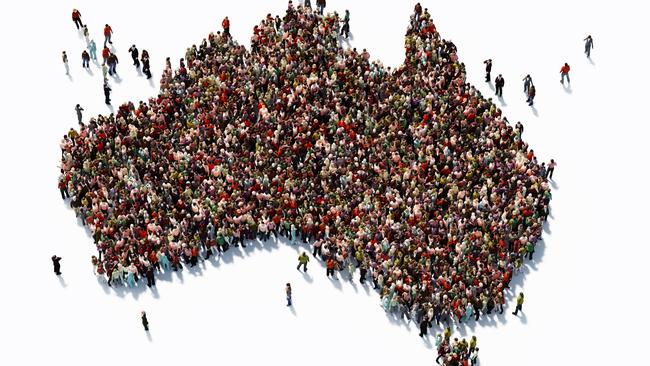Prepare for a slower growing Australia through the 2020s
Without strong population growth, Australia will be a smaller, different place to live.

Since the start of the millennium, Australia added 200,000 new migrants each year — at the peak of 2008 we even added more than 300,000 new residents from overseas. In many respects we planned our economy around the constant intake of new migrants.
Our education system is underwritten by international students, our residential construction sector depends on a steady stream of new residents needing homes and, most important, all the highly skilled jobs that our economy created couldn’t possibly have been filled by the locally available workforce.
Well, that was before COVID. Australia won’t see pre-COVID growth for years. In May, Alan Tudge in his role as the Minister for Population, Cities and Urban Infrastructure said net overseas migration for this year essentially will be zero.
Scott Morrison threw around the number of 34,000 net new migrants for next year.
Without strong population growth, Australia will be a different place. How can we recover from COVID in the context of Small Australia, and is it even appropriate to talk of Australia being small?
Let us understand how small our Small Australia might be. Officially about 60 per cent of population growth is due to migration. This figure is closer to 75 per cent when considering that many of the children born in Australia have at least one migrant parent. Research also shows that in times of economic uncertainty, fewer births are recorded.
The remaining 40 per cent of population growth came from natural increase — population growth because of more births than deaths. The highest natural increase of 162,000 was recorded in 2013. Since then that number declined every year until we reached 139,000 last year. This year’s figures won’t show the real impact of COVID as there is a natural delay of about nine to 10 months for changes in the birthrate to register in data.
Does this mean that starting with next year we will see really low number of total births in Australia? Probably not. During the 2020s the big millennial cohort is reaching the family formation stage of the life cycle and will have babies while the big baby boomer cohort will still be healthy. Even in the years before migration will pick up again, we will see the population grow because of natural increase. Our Small Australia won’t be that small, but it will be small enough to change our country.
Ideally an economy operates with an unemployment rate of around 4 per cent to 5 per cent, to ensure that capable labour is always available. Australia was pretty close to that ideal rate for the better part of this millennium. We therefore needed a skilled migration program aimed at importing qualified workers to fill the new jobs the economy created while roughly maintaining the ideal unemployment rate.
I will let economists argue whether COVID pushed the real unemployment rate to 15 per cent or closer to 20 per cent. Fact is that in times of high unemployment we don’t have the need to import labour as there is enough local talent available — this will naturally change once the economy reaches pre-COVID levels.
During the recovery years there are a few industries that will be especially hit but not all is doom and gloom. Mining, health, public admin, warehousing, utilities, telecom, and agriculture should be able to grow even in times of slower population growth.
Collectively, ownership of dwellings, construction and real estate services make up 19 per cent of Australian gross domestic product. Lower population growth means fewer buildings of all sorts will be needed. Government on all levels is all too aware of the importance of the construction industry. Infrastructure projects have been brought forward to soften the fall.
Median house prices and rents will fall in most markets. Great news for millennials who managed to maintain their incomes during COVID and finally want to become first-home owners, terrible news for retirees who rely on rental incomes or whose only real asset is the family home.
Three other sectors that will suffer before we are back to a pre-COVID economy will be education, tourism, and the arts.
About 40 per cent of migrants are international students who effectively underwrite our education system. They are the first group of foreigners we will want to let back into Australia. The second group is tourists. We have countless towns who depend on tourism. The arts will recover only once full-scale attendance of events of all sorts are possible again but make up only 0.8 per cent of GDP.
If not managed proactively, slowed population growth can leave us a poorer country, one with an ageing population that we can’t afford to pay decent pensions. A quick look at Japan might lighten your mood. The population growth rate has been declining in Japan for five decades and since 2013 the nation has even been shrinking. All the while Japan managed to expand its GDP.
Low birthrates, an ageing population, and an unwillingness to allow a high level of skilled migration meant Japan needed to change its social contract and readjust the economy to achieve economic growth. Women traditionally stopped working once they married. Now Japanese women are increasingly integrated into the workforce. Japan also transitioned its economy into future focused hi-tech sectors.
Australia isn’t Japan but there are lessons to be learnt. In Australia we already have a high share of women in the workforce. But after childbirth women return to the workforce only in a limited part-time capacity. If we wanted to grow our economy with lower migration figures we will need to invest into universal free childcare to ensure a higher full-time employment rate for mothers.
We also need to ensure our economy is structured for the future. Income from mining will help our economy in the short term but we should also invest into the next generation of energy through research and prototype power plants. It also means we must train our workers better. Free TAFE and compulsory regular upskilling could be one way.
While we needn’t have to prepare for a Small Australia we must have an honest conversation about how we want to manage our Slower Growing Australia throughout the 2020s.
Simon Kuestenmacher is co-founder of The Demographics Group.




To join the conversation, please log in. Don't have an account? Register
Join the conversation, you are commenting as Logout